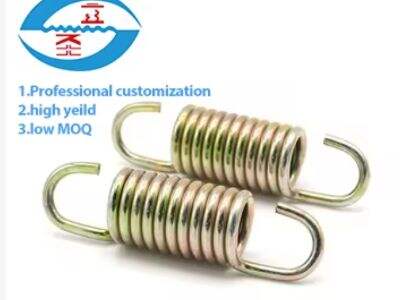Choose the proper tension spring loop type for your assembly when putting things together. They may look like little parts, tension spring loops, but they are extremely important for keeping everything in order.
The Need for Different Tension Spring Types
Spring loops are tiny, but they are strong. They help build tension, seismic pressure that works as a kind of gentle pull that keeps everything from falling apart. There’s no one way to design a Tension Spring loop and each has its own unique style for holding everything in place. Some are round, some square, some even shaped like a hook. It’s critical to know the varieties so you can find a style that will be best suited for your assembly.
Things to Consider When Choosing a Tension Spring Loop Form
If you are choosing a Tension Spring loop type, there are some things you should consider first. One of the key things to consider is the weight that the loop will need to bear. If you are using something heavy you will a strong loop that can handle the pressure. Also, consider the length of the loop. You need to insure that it will fit properly in your assembly neither too big or too small.
A Comparison of Tension Spring Loop Options for Your Assembly
When it comes to Tension Spring loops, you have a whole lot of options. Certain loops are open and others are closed. Open-ended loops are quick to hook and unhook, suitable for something you want to take apart and put back together. In contrast, closed loops offer a better grip, and are less likely to slide off. It’s worth comparing the various options to find the one that proves most functional for your individual jig.
How to Choose the Right Type of Spring Loop for Your Tension Spring Application
For each application, you will have to test a.k.a trial and error, the best type of tension spring loop. Try out various loop types to see which performs best under pressure. Some experts, such as those at Lisheng, also can consult with you to point you in the right direction. If you take the time to test and research will find the proper tension spring loop for your assembly.
Guidelines for Correct Fitting and Maintaining Tension Spring Loops
After you have chosen the correct tension spring loop for your application, it’s essential to install it correctly. Ensure that the loop is tightly strapped on the right position. You might require special tools or methods to get them to grip tightly. You should also regularly inspect and maintain your tension spring loops and use them to check that they are still functioning correctly. If it shows any signs of wear or damage, you should replace the loop before it causes problems.
Table of Contents
- The Need for Different Tension Spring Types
- Things to Consider When Choosing a Tension Spring Loop Form
- A Comparison of Tension Spring Loop Options for Your Assembly
- How to Choose the Right Type of Spring Loop for Your Tension Spring Application
- Guidelines for Correct Fitting and Maintaining Tension Spring Loops

